 Image search results - "obon" Image search results - "obon" |

Yasukuni Shrine during the Mitama Matsuri before dark.
|
|
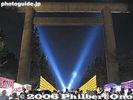
Yasukuni Shrine's main torii during Mitama Matsuri
|
|

Promenade to the shrine
|
|

Spotlights create a silhouette of the statue of Omura Masujiro (1824-1869) 大村益次郎, founder of Japan's modern army.
|
|

A bon dance around the base of the statue.
|
|
|
|

Spotlights hit the torii.
|
|
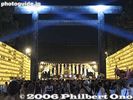
At night, 30,000 lanterns light up. A real summer spectacle.
|
|
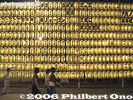
The lanterns are lit by lightbulbs, not candles.
|
|
|

Tanabata streamers festoon the gate.
|
|
|
|

At 6:30 pm, a mikoshi portable shrine was paraded along the promenade.
|
|
|
|
|
|
|
|

One of the giant spotlights used to accent the mikoshi, torii, and night sky.
|
|
|
|
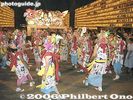
After the mikoshi, the Nebuta float and haneto dancers make an appearance.
|
|
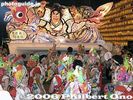
Rassera-rassera!
|
|

Nebuta float and haneto dancers. Also see the video at YouTube.Mitama Mtasuri at Yasukuni Shrine.
|
|

Awa Odori dancers also performed.
|
|
|
|

Nebuta close-up
|
|

Nice to see a bit of Aomori in Tokyo.
|
|
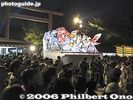
After the Nebuta made its way in front of the shrine, a short prayer was held.
|
|
|
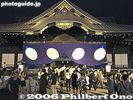
The shrine
|
|

The Nebuta then went back to the promenade.
|
|
|
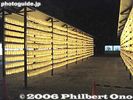
Lanterns
|
|
|

The lanterns are written with the names of the donors.
|
|
|

Stage entertainment is also provided during the festival.
|
|
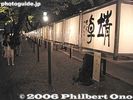
The bigger lanterns have artwork. Some of them were done by celebrities.
|
|
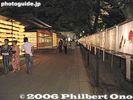
Path to the Yushukan war museum.
|
|
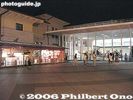
Yushukan war museum
|
|

Next to the museum was a display of different lanterns, including a Neputa (left) and Nebuta (right).
|
|
|
|
|

Neputa is from Hirosaki, Aomori Pref.
|
|

Neputa closeup
|
|
|
|
|
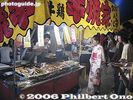
Food stall
|
|
|
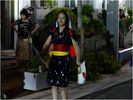
Eisa dancing is performed on the streets at night in every village on Okinawa during the three days of Obon, late in August. Here a young lady dressed in traditional Okinawan yukata (an informal kimono) marches while waving Rising Sun paper fans.Photo copyright 2009 Michael Lynch.
|
|
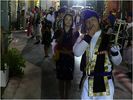
During each brief pause in the Eisa music, the men make a loud whistling noise that is distinctly Okinawan. All photos copyright 2009 Michael Lynch.Photo copyright 2009 Michael Lynch.
|
|
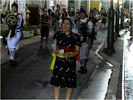
The Eisa dancers are all unmarried men and women between 20 and 30 years of age. The small handheld drums, known as Panraku, have the traditional symbol of Okinawa painted in gold on them.Photo copyright 2009 Michael Lynch.
|
|
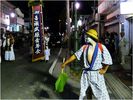
The Buffoon, Clown, or Town Drunk is a man who zig-zags through the line of dancers to the beat of his own drum, entertaining everyone and chasing evil spirits away.Photo copyright 2009 Michael Lynch.
|
|
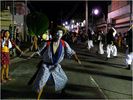
Here the Buffoon (called Gajangani) can be seen going in the opposite direction of all the other male dancers and waving a banana leaf. Some clowns carry bottles of sake and try to get bystanders to drink with them.Photo copyright 2009 Michael Lynch.
|
|
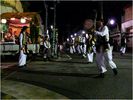
Each team of Eisa dancers has its own band riding in the back of a straw roof-covered truck. Sanshin (3 stringed instrument) players sing and play Okinawan folk music accompanied by CD’s blasted over a loudspeaker system. Photo copyright 2009 Michael Lynch.
|
|
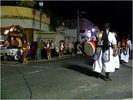
Different color yukata and uniforms of the dancers are worn, depending on which district or village they represent.Photo copyright 2009 Michael Lynch.
|
|

The large banner or flag carried on a bamboo pole is known as Hatagashisa and also represents a village or district. Each has their own unique design and the team takes pride in displaying it as a symbol of strength and prosperity for their hometown.Photo copyright 2009 Michael Lynch.
|
|
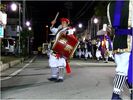
The large drum used for marching is slightly smaller than a Taiko and is called an Odaiko drum. The drummer in this photo is the only female player of this team to play such a large drum and she smiles and beats it enthusiastically.Photo copyright 2009 Michael Lynch.
|
|
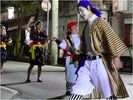
The brown and beige garment worn by this Buffoon is hand woven clothing called Bashofu. It is made from the fiber of banana plants. There may be two or three of these characters with each Eisa group skipping and weaving through the dancers as if they...The brown and beige garment worn by this Buffoon is hand woven clothing called Bashofu. It is made from the fiber of banana plants. There may be two or three of these characters with each Eisa group skipping and weaving through the dancers as if they weren’t there. Photo copyright 2009 Michael Lynch.
|
|
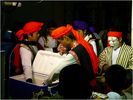
Here a group of men reach into a cooler for some refreshments while on a quick break from dancing. They will pile on trucks and move to the next location, performing Eisa dances well past midnight at every street, in every village for miles around.Photo copyright 2009 Michael Lynch.
|
|
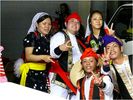
For their parting shot, these Eisa dancers couldn’t resist flashing the Peace sign along with their smiles for the camera. Photo copyright 2009 Michael Lynch.
|
|

Held during the Bon season on Aug. 16, toro nagashi is candle-lit paper lanterns floated on the ocean as a Buddhist offering to the spirits of the deceased.Tsuruga holds its mass toro nagashi (6,000 lanterns) on its famous Kehi no Matsubara beach at 6:30 pm, and then shoots off a grand fireworks display. My video of Toro Nagashi and brilliant marine fireworks taken on Aug. 16, 2017.
|
|

Line to board the free shuttle bus from Tsuruga Station to Kehi no Matsubara Beach.The waiting time was minimal since buses kept coming often. They chartered buses from numerous bus companies.
|
|

15-min. walk from the bus stop to the beach. People everywhere.
|
|

Crowd on Kehi no Matsubara Beach
|
|
|

The crowd stretched to the very far side of the bay.
|
|
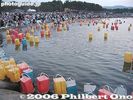
At 6:30 pm, people started releasing their candlelit lanterns into the ocean. Tsuruga, Fukui Pref.
|
|
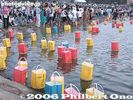
You could buy a lantern for 500 yen. Choice of three colors: Red, blue, and yellow.
|
|

Toro nagashi at Kehi no Matsubara Beach in Tsuruga, Fukui Pref.
|
|
|
|
|
|
|

The lanterns say "For the Spirits of Past Generations."
|
|
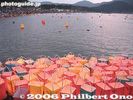
I was sitting on a jetty where many lanterns got stuck. We could feel the hot air from the candles.
|
|
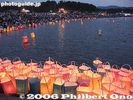
As it got darker, the scene got prettier.
|
|
|
|
|
|
|
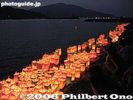
Lanterns along the jetty.
|
|
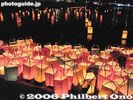
By 7:30 pm, it was completely dark.
|
|
|
|

Fireworks started at 7:30 pm.
|
|

Great match with the lit lanterns and fireworks.
|
|
|

Whoever thought of combining toro nagashi with fireworks was a genius.
|
|

Toro nagashi and fireworks at Tsuruga, Fukui Pref.
|
|

Bright fireworks light up the audience on the beach.
|
|

The fireworks were brilliant and world-class, included a few waterborne "half-dome" fireworks.
|
|

Line for the free shuttle bus back to Tsuruga Station. They had many shuttle buses so we didn't have to wait long.It was a very efficient and quick operation. Although I did leave early.
|
|
|
|
|